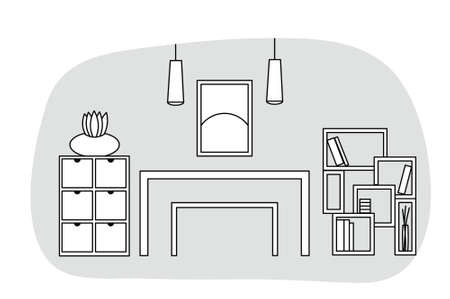Introduction: The Modern Workspace Dilemma
In the ever-evolving landscape of American work culture, the way we set up our desks is getting a major facelift. Standing desks have stormed onto the scene, promising to shake up decades of sitting tradition and redefine what comfort means at the office or home workspace. With remote work on the rise and wellness taking center stage, more folks are swapping out their old-school desks for adjustable setups that let you stand tall while you hustle. But as this trend gains traction from Silicon Valley startups to Midwest home offices, it begs a big question: does your choice of desk really make a difference for your health and daily well-being? The answer might just surprise you—and change the way you look at your 9-to-5 grind.
2. Breaking Down the Basics: What’s the Difference?
When it comes to picking the right desk for your workspace, understanding the basics of standing desks and traditional desks is key—especially in American offices and home setups. Let’s take a closer look at what sets these two options apart.
Standing Desks
Standing desks, sometimes called stand-up desks or sit-stand desks, are designed to allow users to work while standing up or easily switch between sitting and standing. In U.S. workplaces, these have become increasingly popular as part of wellness initiatives aimed at reducing sedentary habits. Adjustable-height versions—either manual crank or electric—let you customize your setup throughout the day.
Common Features of Standing Desks
- Adjustable height (manual or electric)
- Spacious surface for monitors, keyboards, and other essentials
- Cable management systems
- Optional accessories like anti-fatigue mats or monitor arms
- Contemporary styles to match modern office décor
Traditional Desks
Traditional desks are the classic workhorses of American offices and homes. These stationary desks offer a fixed height, typically designed for use with an office chair. They’re known for their stability, ample storage options (think drawers and shelves), and timeless designs that can range from vintage wood to sleek metal finishes.
Common Features of Traditional Desks
- Fixed height (usually around 29-30 inches)
- Integrated storage such as drawers, cabinets, or hutches
- Sturdy construction (wood, metal, laminate)
- Diverse design options—from mid-century to industrial chic
- Large desktop area for paperwork and devices
Quick Comparison Table: Standing vs. Traditional Desks
| Standing Desk | Traditional Desk | |
|---|---|---|
| Height Adjustment | Yes (manual/electric) | No (fixed) |
| Main Use Position | Sitting & Standing | Sitting Only |
| Ergonomic Flexibility | High | Moderate |
| Storage Options | Limited/Minimal | Varied/Ample |
| Popular in U.S. Offices? | Increasingly Yes | Always Yes |
| Main Appeal | Health & Wellness Focused | Classic Functionality & Storage |
This overview sets the stage for exploring which desk truly offers better ergonomic support—so you can make an informed choice for your own workspace.

3. Ergonomics Unpacked: How Each Desk Stacks Up
When it comes to ergonomics, standing desks and traditional desks each have their own vibe—and their own set of perks and pitfalls. Let’s break down the basics, office-style. Standing desks are all about getting you up on your feet. That means less slouching in your chair and a chance to stretch those legs while you answer emails or jump on a Zoom call. Folks who use standing desks often say they feel more energized and less stiff by quitting the all-day sit-a-thon. Plus, you can switch things up throughout the day—sit when you’re tired, stand when you need a boost.
But here’s the flip side: Standing too long can be tough on your knees, hips, and lower back if your setup isn’t dialed in just right. You might find yourself shifting your weight from foot to foot or wishing for some good arch support. That’s where anti-fatigue mats or comfy sneakers come into play—think of them as your ergonomic wingmen.
Traditional desks, on the other hand, are what most of us know best. Pull up an adjustable chair with solid lumbar support, keep your monitor at eye level, and you’ve got a classic ergonomic workstation that can help ward off neck and shoulder pain. Sitting lets you plant your feet flat on the floor (or grab a footrest), and for tasks that require focus—like spreadsheets or deep dives into reports—it can be easier to hunker down and grind it out.
Still, sitting for hours on end is no picnic either. It can lead to stiffness, sore backs, and that notorious “afternoon slump.” The key to any desk setup is mixing it up: shift positions, take stretch breaks, maybe even stroll around during conference calls. Whether you’re Team Standing or Team Sitting, building in movement is what keeps your workday ergonomic—and keeps you feeling groovy from 9 to 5.
4. Real-life Comfort: Stories from the American Office
If you stroll through any modern American office, you’ll spot a real patchwork of workstations—some folks standing tall at their desks, others lounging comfortably in their tried-and-true chairs. The debate between standing desks and traditional desks isn’t just about ergonomics; it’s about daily comfort, productivity, and even a little bit of office culture flair.
Americans Weigh In: Desk Preferences in Action
Let’s look at some everyday tales straight from U.S. workplaces:
- Sarah, Marketing Manager (Chicago): “After switching to a standing desk, my lower back pain eased up, but I had to buy an anti-fatigue mat. Otherwise, my feet were killing me by noon!”
- Mike, Software Engineer (Austin): “I tried a standing desk for three months. Honestly? I missed having a comfy chair to sink into during long coding sessions. Now I use a height-adjustable desk and switch it up throughout the day.”
- Tina, HR Director (Seattle): “Most of our team prefers traditional desks. They say it’s easier to focus when you’re sitting down, especially during Zoom marathons.”
The Good, the Bad, and the Achy
| Praise | Complaint | |
|---|---|---|
| Standing Desks | Boosted energy, less back pain Encourages movement and stretching Feels trendy and modern |
Sore feet and legs Hard to adjust at first Can be distracting in open offices |
| Traditional Desks | Comfortable for long periods Easier to concentrate Great for meetings and calls |
Stiffness after hours of sitting Back or neck pain without ergonomic chairs Not as “cool” or health-focused as standing desks |
Cultural Touchpoints: The American Way of Adapting
Americans are big on personalization—so whether it’s adding a footrest under a traditional desk or decking out a standing station with cup holders and Bluetooth speakers, folks find ways to make their workspace work for them. Some companies even host “Step Challenges,” encouraging employees to move more during the day with adjustable desks as part of the fun.
Takeaway:
The bottom line? There’s no one-size-fits-all answer in the American office. Whether standing or sitting, comfort often comes down to flexibility, personal habits, and a dash of workplace creativity.
5. The Science Speaks: What Do Health Experts Say?
When it comes to the debate between standing desks and traditional desks, recent research and expert opinions offer a nuanced perspective rooted in ergonomics and overall health. Posture is a big buzzword among U.S. workplace wellness advocates, and science backs up its importance—poor posture from sitting for long periods can lead to back pain, neck strain, and even headaches. According to studies published by the CDC and Mayo Clinic, alternating between sitting and standing throughout the day helps reduce physical discomfort and supports better spinal alignment.
Health experts recommend frequent movement as part of any workstation setup. The American Heart Association highlights that prolonged sitting is linked to increased risks of heart disease and diabetes, while too much standing can also cause joint fatigue or varicose veins. Thus, most occupational health professionals suggest the “sit-stand-switch” method, encouraging employees to change positions every 30-60 minutes.
In line with popular U.S. trends like corporate step challenges and wearable fitness trackers, there’s growing support for integrating activity into the workday—not just relying on furniture alone. Ultimately, both desk types have their pros and cons; what matters most is incorporating movement, maintaining ergonomic posture, and customizing your workspace to fit your body’s needs.
6. Finding Your Fit: Tips for Making the Switch
Ready to level up your workspace? Whether you’re eyeing a standing desk or sticking with a traditional setup, finding the right fit is key—especially here in the U.S., where home offices can be anything from a spare bedroom to a cozy corner in a studio apartment. Let’s break down some practical, all-American advice for making your next desk move smooth and smart.
Consider Your Space—and Lifestyle
First things first: measure twice, buy once! American homes run the gamut from sprawling ranch houses to city apartments, so make sure your new desk fits your space. Standing desks often have a bigger footprint or require more vertical room. If you’re working in tight quarters, look for compact or adjustable models that won’t crowd your style—or your living room.
Budget Like a Boss
Standing desks can range from affordable DIY solutions (think: stacking books for a trial run) to high-end electric models with all the bells and whistles. Set a budget before you shop and don’t forget about hidden costs like anti-fatigue mats or accessories. Many American retailers offer seasonal sales—keep an eye out during back-to-school or Black Friday events for major deals.
Tune In to Your Work Habits
Your daily grind matters. Are you glued to Zoom calls all day? Or do you bounce between emails and hands-on projects? If you like to move around, an adjustable sit-stand desk could give you flexibility without interrupting your workflow. For those who thrive on routine, a classic desk might still be your best bet—just invest in an ergonomic chair and take regular stretch breaks.
Try Before You Buy
If possible, swing by local office supply stores (like Staples or Office Depot) and test different setups. Some American companies even let employees borrow standing desks for home trials—don’t be shy about asking HR if this is an option.
Small Changes, Big Results
You don’t have to overhaul everything overnight. Start slow: stand for 20-30 minutes each hour, adjust your monitor height, and listen to your body. Americans are big on personalizing their spaces—add plants, vintage lamps, or retro knick-knacks that make your workspace feel uniquely yours while keeping comfort top of mind.
Ultimately, whether you choose to stand tall or sit pretty, the best desk is one that supports your health, productivity, and American lifestyle. Make the switch at your own pace—and remember: ergonomics isn’t just about furniture; it’s about feeling good while getting things done.
7. Conclusion: Making the Choice that Works for You
When it comes to choosing between standing desks and traditional desks, there’s no one-size-fits-all answer—especially in a country as diverse and dynamic as the United States. The best option for you depends on your unique work style, daily routine, and personal comfort. Start by considering how much time you spend at your desk, what kind of work you do, and how your body feels throughout the day. Are you someone who thrives on movement and likes to switch things up? Or do you prefer a classic setup with a comfy chair and everything within easy reach?
Think about your workspace, too. Many American offices are embracing flexible layouts and hybrid work models, so maybe a sit-stand combo fits your needs better than sticking to just one style. If youre working from home, weigh the pros and cons of upgrading your furniture versus making small ergonomic tweaks to what you already have. Remember, investing in your health now can pay off big time down the road.
Ultimately, listen to your body—after all, its the real expert here. Try different setups if possible and don’t be afraid to mix things up until you find what works best for you. Whether youre hustling in a downtown high-rise or dialing in from your cozy kitchen table, prioritize comfort and well-being above all else. Your desk should work for you—not the other way around.


